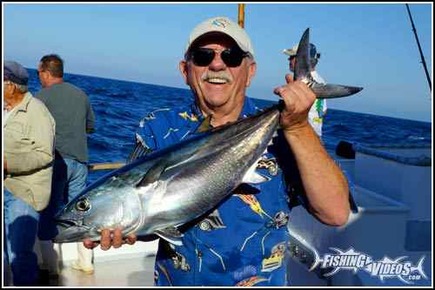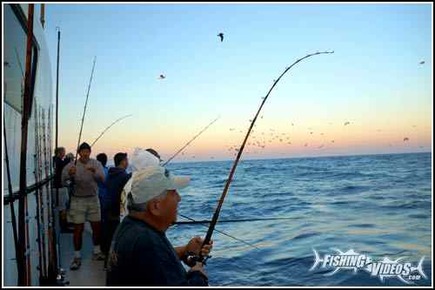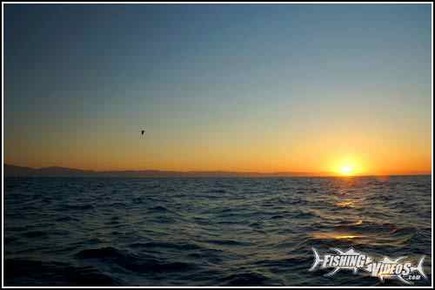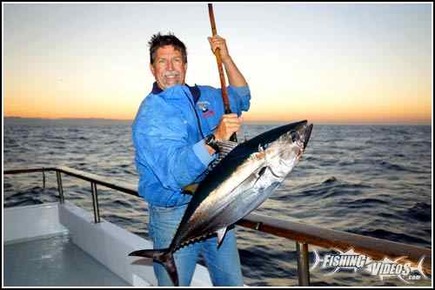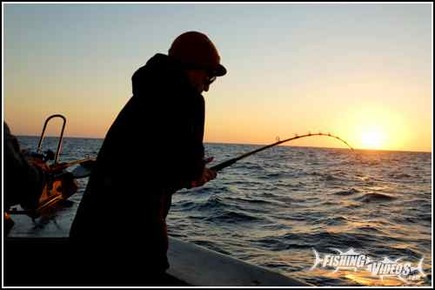Long Range Fish Report
From Sportfishing
From Sportfishing
Fish Report for 10-23-2013
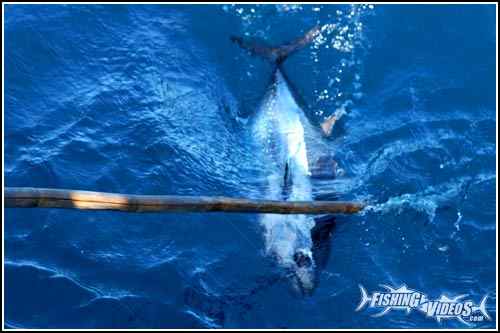
Is the Bluefin bite better during a Full Moon
10-23-2013
Bill Roecker
Many, if not the majority of bluefin anglers believe the best fishing for the species comes on the full moon. There's a good deal of anecdotal evidence to support this contention, and my trip aboard the Prowler with owner-skipper Buzz Brizendine would support that school of thought.
When we rode down to the Sausage Bank the evening of October 17, the breeze came up behind us as we motored downhill, but we couldn't really feel it down in the bunkroom. The swell was small, and the boat rocked very little until we stopped just before dawn. The wind came up a bit, just as crewman JK predicted. He said he knew it would, because of the heavy dew.
"When there's a heavy dew the breeze will be up on the water the next day," he foretold. I was up twice during the night, and amazed by the scene when I got out on deck. The full moon was overhead, and the shore was lit up like Los Angeles. There was so much light on the water that it glinted from every faceted surface of the Pacific, like bright sun on ruffled water. So much light you could read a contract except for the fine print.
It was one of the prettiest full moon nights I can remember, including some memorable ones off Puerto Vallarta. The lights on the Mexican shore seemed to go on north and south forever, in stark contrast to the darkness we used to see south of Tijuana, when the next lighted spot was Rosarito Beach or Ensenada. Wikipedia says, "The geographic city limits of Rosarito Beach Municipality are quite large, abutting the Tijuana city limits to the north, and Ensenada to the south along the coast and inland, however, the core settlement is compact."
When we stopped in the morning the moon was just setting as the sun rose. It was a powerful reason to be out on the water in October, fishing with a light load of anglers under clear skies during a decent fall bite. It took me back to when I first started to fish offshore, and why I came to like it so much.
During the day's fishing I kept the camera in my hand, though I fished a bit in the morning and again in the afternoon when bluefin were nibbling. When we fished kelp mats in the afternoon for small yellowtail I tried to get a good vantage point to watch and shoot the action, and skipper Brizendine saw me chuckling as the hooked-up anglers (virtually everyone) struggled to keep their fish separated long enough to bounce 'em.
"This is the next generation of cow fishermen," he remarked. That took me back to my own early days of fishing on half-day and overnight boats. "I know it," I said. "It works."
In the morning I fished with a new outfit, an eight-foot custom Seeker rod built for me by Pat Doyle. Pat's a well-known long ranger with a 300-pounder crossed off his bucket list. A Seaguar leader with a 3/0 pre-tied 3/0 Owner hook on 30-pound Izorline XXX on an Accurate Boss 197 reel completed the outfit. It was light and easy to handle.
I didn't have an easy time getting a bite, but I got one on a long soak (It looked like that was the case for the majority of us), having started at the stern and crab-walked up the starboard side to just short of the bow. Those early bites were hard to detect for many of us, probably because the baits were out there over 100 yards. A tuna that bites at long distance may be swimming toward the boat when it takes the bait. An angler may not know he's been picked up until he feels slack, or the fish turns or dives. Call it a soft bite. That why it's a good idea to wind in a bit of line every so often. With a nosehooked sardine you might tease a bite that way, or notice, as I did, that there's a fish on.
When I realized I'd been bit and cranked the handle the fish felt like it was coming along too easily. It came to the boat and went past the bow, so I walked down the port side and wound it in. It only took a minute or two before I presented it to the gaffer, so it may have been heart-hooked, having had plenty of time to swallow the sardine before I was aware I'd been bit. Buzz and I both took a moment to pose with the bluefin, a good-looking fish.
Encouraged, I put out another bait, had another nibble after a five or ten-minute soak, and reeled in a sardine with a crushed head and teeth marks on the body. The sardines were very large, and I surmised a bit of a wait before attempting a hookset might be a good idea.
We trolled around during the midday hours, and twice we spotted a pod of blue whales. During the first bite we experienced in the afternoon, around four P.M., my gear was already broken down. I used a boat rig to catch my second bluefin. It had 30-pound monofilament straight-tied to the 3/0 Mustad hook. That school behaved in a different way from the fish we encountered early in the morning, and stealth wasn't the most important part of making a connection. These fish came to the boat, and a lively bait off the stern was quickly bit. Several fish were hooked and brought aboard. Mine was close to 30 pounds, the gaffer said.
We finished up at sunset with one last bluefin, and our cook served up a chicken breast dinner. It cooled off fast, and the breeze took a chill.
"It's not August anymore," remarked Buzz.
Then the moon came up again, huge and bright as the night before. I looked at the awesome coastal scene again twice during the night. In the morning we arrived at a soggy gray Fisherman's Landing. There was heavy dew on our vehicles, and fog in the coastal valleys, just like the night before.
"When there's a heavy dew the breeze will be up on the water the next day," he foretold. I was up twice during the night, and amazed by the scene when I got out on deck. The full moon was overhead, and the shore was lit up like Los Angeles. There was so much light on the water that it glinted from every faceted surface of the Pacific, like bright sun on ruffled water. So much light you could read a contract except for the fine print.
It was one of the prettiest full moon nights I can remember, including some memorable ones off Puerto Vallarta. The lights on the Mexican shore seemed to go on north and south forever, in stark contrast to the darkness we used to see south of Tijuana, when the next lighted spot was Rosarito Beach or Ensenada. Wikipedia says, "The geographic city limits of Rosarito Beach Municipality are quite large, abutting the Tijuana city limits to the north, and Ensenada to the south along the coast and inland, however, the core settlement is compact."
When we stopped in the morning the moon was just setting as the sun rose. It was a powerful reason to be out on the water in October, fishing with a light load of anglers under clear skies during a decent fall bite. It took me back to when I first started to fish offshore, and why I came to like it so much.
During the day's fishing I kept the camera in my hand, though I fished a bit in the morning and again in the afternoon when bluefin were nibbling. When we fished kelp mats in the afternoon for small yellowtail I tried to get a good vantage point to watch and shoot the action, and skipper Brizendine saw me chuckling as the hooked-up anglers (virtually everyone) struggled to keep their fish separated long enough to bounce 'em.
"This is the next generation of cow fishermen," he remarked. That took me back to my own early days of fishing on half-day and overnight boats. "I know it," I said. "It works."
In the morning I fished with a new outfit, an eight-foot custom Seeker rod built for me by Pat Doyle. Pat's a well-known long ranger with a 300-pounder crossed off his bucket list. A Seaguar leader with a 3/0 pre-tied 3/0 Owner hook on 30-pound Izorline XXX on an Accurate Boss 197 reel completed the outfit. It was light and easy to handle.
I didn't have an easy time getting a bite, but I got one on a long soak (It looked like that was the case for the majority of us), having started at the stern and crab-walked up the starboard side to just short of the bow. Those early bites were hard to detect for many of us, probably because the baits were out there over 100 yards. A tuna that bites at long distance may be swimming toward the boat when it takes the bait. An angler may not know he's been picked up until he feels slack, or the fish turns or dives. Call it a soft bite. That why it's a good idea to wind in a bit of line every so often. With a nosehooked sardine you might tease a bite that way, or notice, as I did, that there's a fish on.
When I realized I'd been bit and cranked the handle the fish felt like it was coming along too easily. It came to the boat and went past the bow, so I walked down the port side and wound it in. It only took a minute or two before I presented it to the gaffer, so it may have been heart-hooked, having had plenty of time to swallow the sardine before I was aware I'd been bit. Buzz and I both took a moment to pose with the bluefin, a good-looking fish.
Encouraged, I put out another bait, had another nibble after a five or ten-minute soak, and reeled in a sardine with a crushed head and teeth marks on the body. The sardines were very large, and I surmised a bit of a wait before attempting a hookset might be a good idea.
We trolled around during the midday hours, and twice we spotted a pod of blue whales. During the first bite we experienced in the afternoon, around four P.M., my gear was already broken down. I used a boat rig to catch my second bluefin. It had 30-pound monofilament straight-tied to the 3/0 Mustad hook. That school behaved in a different way from the fish we encountered early in the morning, and stealth wasn't the most important part of making a connection. These fish came to the boat, and a lively bait off the stern was quickly bit. Several fish were hooked and brought aboard. Mine was close to 30 pounds, the gaffer said.
We finished up at sunset with one last bluefin, and our cook served up a chicken breast dinner. It cooled off fast, and the breeze took a chill.
"It's not August anymore," remarked Buzz.
Then the moon came up again, huge and bright as the night before. I looked at the awesome coastal scene again twice during the night. In the morning we arrived at a soggy gray Fisherman's Landing. There was heavy dew on our vehicles, and fog in the coastal valleys, just like the night before.
Photos
< Previous Report Next Report >
More Reports
Fishing Videos Reports
for Thursday, October 17th, 2013• Despite a storm in Mexico Red Rooster III has a nice catch of Dorado & Wahoo
• Despite some tough going (getting the Bluefin they saw to bite) the Royal Polaris persists
• American Angler returns from their M & M Custom Rods trip
• The San Diego Fleet's Bluefin Season is proving noteworthy
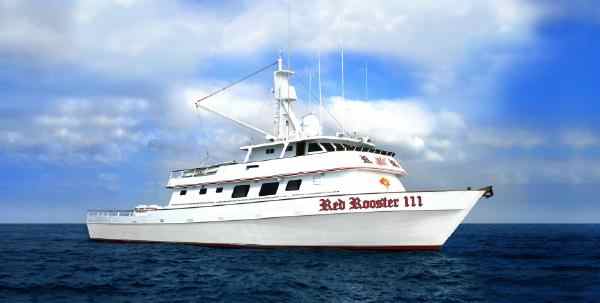
10-15-2013
"We had a nice morning of yellowtail fishing," reported Andy Cates for the Red Rooster III October 14. "We left...... Read More

LongRangeSportfishing.net © 2025. All Rights Reserved.
Website Hosting and Design provided by TECK.net
Website Hosting and Design provided by TECK.net
